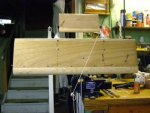RotoPlane
Gold Supporter
Notice how straight the lift graph line is in Rotorblade3B UL.jpg…..a rectangular blade would have that line looking like a pot-bellied pig. There is more auto-rotational pull available in this middle driver section.
With 3-blades, this blade profile also has more lift than I wanted with the 7" tips, so I had to go down to a 6" tip. I was surprised how far outb'd the lift centroid or CP fell. The spreadsheet spec.'s are shown in that *.doc file and that data agrees with this drawing.
The forums 150 kb limit doesn't allow hardly anything to be uploaded that I tried....and then it's mostly to grainy to see well. I once was able to use .pdf's for most stuff...rarely can get one to upload now...sorry.
Anyway, I thought I'd show you the way I'm headed....thanks Chuck B. for warning me about using 2-blades with my rotorhead.
With 3-blades, this blade profile also has more lift than I wanted with the 7" tips, so I had to go down to a 6" tip. I was surprised how far outb'd the lift centroid or CP fell. The spreadsheet spec.'s are shown in that *.doc file and that data agrees with this drawing.
The forums 150 kb limit doesn't allow hardly anything to be uploaded that I tried....and then it's mostly to grainy to see well. I once was able to use .pdf's for most stuff...rarely can get one to upload now...sorry.
Anyway, I thought I'd show you the way I'm headed....thanks Chuck B. for warning me about using 2-blades with my rotorhead.
Last edited:

